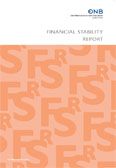Financial Stability Report 23
 OeNB
OeNB
- published:
- June 2012.
 OeNB
OeNB
Financial Stability Report 23 (PDF, 2.7 MB) June 2012.
Management Summary (PDF, 2.4 MB) en Jun 15, 2012, 12:00:00 AM
CESEE: Modest Impact of Sovereign Debt Crisis (PDF, 2.3 MB) en Jun 15, 2012, 12:00:00 AM
Austria’s Real Economy: Slight Increase in Corporate Debt (PDF, 2.3 MB) en Jun 15, 2012, 12:00:00 AM
Austrian Financial Intermediaries Burdened By Difficult International Environment (PDF, 2.5 MB) en Jun 15, 2012, 12:00:00 AM
Ukrainian Banks Face Heightened Uncertainty and Challenges (PDF, 2.4 MB) Barisitz, Gunter, Lahnsteiner. Following a sharp recession in 2009, the Ukrainian economy recovered in 2010 and 2011. In particular in 2011, domestic demand-led growth was accompanied by widening external imbalances. The economy’s external vulnerabilities – related to the current account deficit (2011: 5.6% of GDP) and the elevated foreign debt stock (77% of GDP) – entail risks for the banking sector, as exchange rate pressures against the hryvnia’s U.S. dollar peg have been recurrent and foreign exchange reserves declined in the second half of 2011. While the share of foreign currency loans in total loans has been steadily declining (thanks to a ban on extending new foreign currency loans to unhedged borrowers imposed by the National Bank of Ukraine in the fall of 2008), it remains sizeable (end-2011: 41%). Many of these loans are unhedged. The stabilization of nonperforming loans at a high level could be interrupted by a further deterioration of the economic situation or by a new bout of hryvnia depreciation. Moreover, the population’s confidence in the Ukrainian currency is prone to volatile swings. As deposit inflows have picked up and loan growth has remained subdued, the loan-to-deposit ratio has receded, but is still relatively high (end-2011: 163%). With the funding structure shifting to domestic deposits, the banking sector’s external position has improved (net external liabilities have fallen to 8% of total liabilities). In 2011, loan growth became positive in real terms again. Recapitalization efforts contributed to upholding capital adequacy. The banking sector’s profitability improved, but nevertheless stayed in negative territory. en Banking sector, banking crisis, nonperforming loans, external vulnerabilities, recapitalization, Ukraine G21, G28, P34 Jun 15, 2012, 12:00:00 AM
Risk Buffer Profiles of Foreign Currency Mortgage Holders (PDF, 2.5 MB) Albacete, Fessler, Schürz. In Austria, the share of foreign currency mortgages in total household debt has been increasing since the late 1990s. Today about one-third of household credit debt is denominated in foreign currency, mostly in Swiss francs. A major issue with regard to the resulting implications for financial stability is the vulnerability of indebted households. Do foreign currency borrowers opt for foreign currency loans because they cannot afford a given loan in domestic currency? Or are foreign currency borrowers just less risk averse and better able to absorb risks than their domestic currency counterparts? We employ a subsample of the Household Survey on Housing Wealth 2008 for the first borrower analysis of this kind for Austria. Using simple linear regression techniques may be misleading given the heterogeneity of borrowers’ characteristics and the heterogeneity of differences along risk buffers. Hence we estimate conditional counterfactual distributions in order to calculate the differences in terms of risk buffers between foreign currency borrowers and their domestic currency counterparts over the entire marginal distributions of the risk buffers. We find that foreign currency borrowers have substantially higher risk buffers than their domestic currency counterparts and therefore reject the hypothesis that most of them have loans in foreign currency because they would not be able to afford the same amounts in domestic currency on account of the higher interest rate burden. en Foreign currency borrowing, mortgages, risk, Austria, Swiss francs, household indebtedness D10, D14, D31, D39, E44, E17 Jun 15, 2012, 12:00:00 AM
Intra-Group Cross-Border Credit and Roll-Over Risks in CESEE – Evidence from Austrian Banks (PDF, 2.5 MB) Hameter, Lahnsteiner, Vogel. During the last decade several CESEE countries built up high external liabilities vis-à-vis foreign banking sectors, with Austrian banks being important creditors. The provision of crossborder credit allowed for rapid financial deepening in many of these countries but also led to a build-up of vulnerabilities to negative spillovers. This study points out that Austrian banks granted a considerable part of direct cross-border credit to affiliated borrowers in CESEE, in particular to their own bank subsidiaries. To our knowledge, this is the first paper that examines the differences between direct cross-border lending to affiliates and direct crossborder lending to nonaffiliates. Our analysis shows that intra-group cross-border credit from Austrian banks was more stable than lending to nonaffiliated borrowers during the 2008/09 financial crisis period. We argue that this is due to lower information asymmetries and parent banks’ efforts to provide their subsidiaries with liquidity in times of financial distress to support their investments. en Financial stability, banking sector, Central and Eastern Europe, refinancing, funding, capital flows, roll-over, financial crisis E44, G21, G32 Jun 15, 2012, 12:00:00 AM
Annex of Tables (PDF, 1.9 MB) en Jun 15, 2012, 12:00:00 AM
Notes (PDF, 1.6 MB) en Jun 15, 2012, 12:00:00 AM